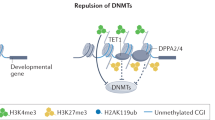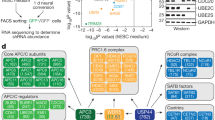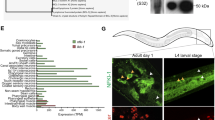Abstract
The Wnt signalling pathway is pivotal in normal and malignant development. A key effector is Armadillo (Arm)/β-catenin, which functions with TCF to transcribe Wnt target-genes. Here, we report the discovery of pygopus (pygo), whose mutant phenotypes specifically mimic loss-of-Wingless (Wg) signalling. pygo is required for dTCF-mediated transcription, but not for Wg-induced stabilization of Arm. Pygo is a nuclear protein that is found in a complex with Arm in vivo. Humans possess two Pygo proteins, both of which are required for TCF-mediated transcription in colorectal cancer cells. The presence of a PHD domain implicates Pygo proteins in a chromatin-related function, and we propose that they mediate chromatin access to TCF or Arm/β-catenin.
This is a preview of subscription content, access via your institution
Access options
Subscribe to this journal
Receive 12 print issues and online access
$209.00 per year
only $17.42 per issue
Buy this article
- Purchase on Springer Link
- Instant access to full article PDF
Prices may be subject to local taxes which are calculated during checkout






Similar content being viewed by others
References
Cadigan, K. M. & Nusse, R. Wnt signaling: a common theme in animal development. Genes Dev. 11, 3286–3305 (1997).
Perrimon, N. The genetic basis of patterned baldness in Drosophila. Cell 76, 781–784 (1994).
Miller, J. R. & Moon, R. T. Signal transduction through β-catenin and specification of cell fate during embryogenesis. Genes Dev. 10, 2527–2539 (1996).
Polakis, P. Wnt signaling and cancer. Genes Dev. 14, 1837–1851 (2000).
Bienz, M. & Clevers, H. Linking colorectal cancer to Wnt signaling. Cell 103, 311–320 (2000).
Morin, P. J. et al. Activation of β-catenin-Tcf signaling in colon cancer by mutations in β-catenin or APC. Science 275, 1787–1790 (1997).
Freeman, M. & Bienz, M. EGF receptor/Rolled MAP kinase signalling protects cells against activated Armadillo in the Drosophila eye. EMBO Rep. 2, 157–162 (2001).
Baker, N. E. Embryonic and imaginal requirements for wingless, a segment-polarity gene in Drosophila. Dev. Biol. 125, 96–108 (1988).
Peifer, M., Rauskolb, C., Williams, M., Riggleman, B. & Wieschaus, E. The segment polarity gene armadillo interacts with the Wingless signaling pathway in both embryonic and adult pattern formation. Development 111, 1029–1043 (1991).
van de Wetering, M. et al. Armadillo coactivates transcription driven by the product of the Drosophila segment polarity gene dTCF. Cell 88, 789–799 (1997).
Brunner, E., Peter, O., Schweizer, L. & Basler, K. Pangolin encodes a Lef-1 homologue that acts downstream of Armadillo to transduce the Wingless signal in Drosophila. Nature 385, 829–833 (1997).
Phillips, R. G. & Whittle, J. R. Wingless expression mediates determination of peripheral nervous system elements in late stages of Drosophila wing disc development. Development 118, 427–438 (1993).
Couso, J. P., Bishop, S. A. & Martinez Arias, A. The Wingless signalling pathway and the patterning of the wing margin in Drosophila. Development 120, 621–636 (1994).
Neumann, C. & Cohen, S. Morphogens and pattern formation. Bioessays 19, 721–729 (1997).
Blair, S. S. & Ralston, A. Smoothened-mediated Hedgehog signalling is required for the maintenance of the anterior-posterior lineage restriction in the developing wing of Drosophila. Development 124, 4053–4063 (1997).
Rodriguez, I. & Basler, K. Control of compartmental affinity boundaries by Hedgehog. Nature 389, 614–618 (1997).
Sturtevant, M. A. & Bier, E. Analysis of the genetic hierarchy guiding wing vein development in Drosophila. Development 121, 785–801 (1995).
Freeman, M. Reiterative use of the EGF receptor triggers differentiation of all cell types in the Drosophila eye. Cell 87, 651–660 (1996).
Dominguez, M. & Hafen, E. Hedgehog directly controls initiation and propagation of retinal differentiation in the Drosophila eye. Genes Dev. 11, 3254–3264 (1997).
Pai, L. M., Orsulic, S., Bejsovec, A. & Peifer, M. Negative regulation of Armadillo, a Wingless effector in Drosophila. Development 124, 2255–2266 (1997).
Yoffe, K. B., Manoukian, A. S., Wilder, E. L., Brand, A. H. & Perrimon, N. Evidence for engrailed-independent wingless autoregulation in Drosophila. Dev. Biol. 170, 636–650 (1995).
Bejsovec, A. & Martinez Arias, A. Roles of wingless in patterning the larval epidermis of Drosophila. Development 113, 471–485 (1991).
Thüringer, F., Cohen, S. M. & Bienz, M. Dissection of an indiret autoregulatory response of a homeotic Drosophila gene. EMBO J. 12, 2419–2430 (1993).
Riese, J. et al. LEF-1, a nuclear factor coordinating signaling inputs from wingless and decapentaplegic. Cell 88, 777–787 (1997).
Yu, X., Hoppler, S., Eresh, S. & Bienz, M. Decapentaplegic, a target gene of the wingless signalling pathway in the Drosophila midgut. Development 122, 849–858 (1996).
Zecca, M., Basler, K. & Struhl, G. Direct and long-range action of a wingless morphogen gradient. Cell 87, 833–844 (1996).
Peifer, M., Sweeton, D., Casey, M. & Wieschaus, E. Wingless signal and Zeste-white 3 kinase trigger opposing changes in the intracellular distribution of Armadillo. Development 120, 369–380 (1994).
Rulifson, E. J., Micchelli, C. A., Axelrod, J. D., Perrimon, N. & Blair, S. S. Wingless refines its own expression domain on the Drosophila wing margin. Nature 384, 72–74 (1996).
Aasland, R., Gibson, T. J. & Stewart, A. F. The PHD finger: implications for chromatin-mediated transcriptional regulation. Trends Biochem. Sci. 20, 56–59 (1995).
Pascual, J., Martinez-Yamout, M., Dyson, H. J. & Wright, P. E. Structure of the PHD zinc finger from human Williams-Beuren syndrome transcription factor. J. Mol. Biol. 304, 723–729 (2000).
Capili, A. D., Schultz, D. C., Rauscher, I. F. & Borden, K. L. Solution structure of the PHD domain from the KAP-1 corepressor: structural determinants for PHD, RING and LIM zinc-binding domains. EMBO J. 20, 165–177 (2001).
Jacobson, S. & Pillus, L. Modifying chromatin and concepts of cancer. Curr. Opin. Genet. Dev. 9, 175–184 (1999).
Roose, J. et al. The Xenopus Wnt effector XTcf-3 interacts with Groucho-related transcriptional repressors. Nature 395, 608–612 (1998).
Waltzer, L. & Bienz, M. Drosophila CBP represses the transcription factor TCF to antagonize Wingless signalling. Nature 395, 521–525 (1998).
Elbashir, S. M. et al. Duplexes of 21-nucleotide RNAs mediate RNA interference in cultured mammalian cells. Nature 411, 494–498 (2001).
Korinek, V. et al. Constitutive transcriptional activation by a β-catenin-Tcf complex in APC-/- colon carcinoma. Science 275, 1784–1787 (1997).
Roose, J. & Clevers, H. TCF transcription factors: molecular switches in carcinogenesis. Biochim. Biophys. Acta 1424, M23–M37 (1999).
Levanon, D. et al. Transcriptional repression by AML1 and LEF-1 is mediated by the TLE/Groucho corepressors. Proc. Natl Acad. Sci. USA 95, 11590–11595 (1998).
Brannon, M., Brown, J. D., Bates, R., Kimelman, D. & Moon, R. T. XCtBP is a XTcf-3 co-repressor with roles throughout Xenopus development. Development 126, 3159–3170 (1999).
Hecht, A., Vleminckx, K., Stemmler, M. P., van Roy, F. & Kemler, R. The p300/CBP acetyltransferases function as transcriptional coactivators of β-catenin in vertebrates. EMBO J. 19, 1839–1850 (2000).
Takemaru, K. I. & Moon, R. T. The transcriptional coactivator CBP interacts with β-catenin to activate gene expression. J. Cell Biol. 149, 249–254 (2000).
Barker, N. et al. The chromatin remodelling factor Brg-1 interacts with β-catenin to promote target gene activation. EMBO J. 20, 4935–4943 (2001).
Tutter, A. V., Fryer, C. J. & Jones, K. A. Chromatin-specific regulation of LEF-1-β-catenin transcription activation and inhibition in vitro. Genes Dev. 15, 3342–3354 (2001).
Daniels, D. L., Eklof Spink, K. & Weis, W. I. β-catenin: molecular plasticity and drug design. Trends Biochem. Sci. 26, 672–678 (2001).
Hsu, S. C., Galceran, J. & Grosschedl, R. Modulation of transcriptional regulation by LEF-1 in response to Wnt-1 signaling and association with β-catenin. Mol. Cell. Biol. 18, 4807–4818 (1998).
von Kries, J. P. et al. Hot spots in β-catenin for interactions with LEF-1, conductin and APC. Nature Struct. Biol. 7, 800–807 (2000).
Yokoya, F., Imamoto, N., Tachibana, T. & Yoneda, Y. β-catenin can be transported into the nucleus in a Ran-unassisted manner. Mol. Biol. Cell 10, 1119–1131 (1999).
Wiechens, N. & Fagotto, F. CRM1- and Ran-independent nuclear export of β-catenin. Curr. Biol. 11, 18–27 (2001).
Tolwinski, N. S. & Wieschaus, E. Armadillo nuclear import is regulated by cytoplasmic anchor Axin and nuclear anchor dTCF/Pan. Development 128, 2107–2117 (2001).
Eklof Spink, K., Fridman, S. G. & Weis, W. I. Molecular mechanisms of β-catenin recognition by adenomatous polyposis coli revealed by the structure of an APC–β-catenin complex. EMBO J. 20, 6203–6212 (2001).
Sanson, B., White, P. & Vincent, J. P. Uncoupling cadherin-based adhesion from wingless signalling in Drosophila. Nature 383, 627–630 (1996).
Neumann, C. J. & Cohen, S. M. Long-range action of Wingless organizes the dorsal-ventral axis of the Drosophila wing. Development 124, 871–880 (1997).
Van de Wetering, M., Castrop, J., Korinek, V. & Clevers, H. Extensive alternative splicing and dual promoter usage generate Tcf-1 protein isoforms with differential transcription control properties. Mol. Cell. Biol. 16, 745–752 (1996).
McCartney, B. M. et al. Drosophila APC2 and Armadillo participate in tethering mitotic spindles to cortical actin. Nature Cell Biol. 3, 933–938 (2001).
Rosin-Arbesfeld, R., Townsley, F. & Bienz, M. The APC tumour suppressor has a nuclear export function. Nature 406, 1009–1012 (2000).
Acknowledgements
We would like to thank A. Baonza, M. van Beest, C. Murawsky and M. Frasch for antibodies, B. Nichols and S. Munro for RNA oligomers, H. Clevers and S. Munro for plasmids, A. Baonza for technical advice on wing discs, and H. Pelham, M. Freeman and A. Travers for critical comments on the manuscript. Thanks also to R. Nusse for suggesting the name Pygopus, a legless and scaly lizard, reminiscent of the pygopus mutant phenotype. R.R.-A. is supported by an EMBO Long-term fellowship.
Author information
Authors and Affiliations
Corresponding author
Ethics declarations
Competing interests
The authors declare no competing financial interests.
Supplementary information
Figure S1.Suppression of the Armadillo* phenotype by pygo.
Figure S2. Embryonic expression of pygo. (PDF 471 kb)
Figure S3. Armadillo is less nuclear in pygo mutant embryos.
Rights and permissions
About this article
Cite this article
Thompson, B., Townsley, F., Rosin-Arbesfeld, R. et al. A new nuclear component of the Wnt signalling pathway. Nat Cell Biol 4, 367–373 (2002). https://doi.org/10.1038/ncb786
Received:
Revised:
Accepted:
Published:
Issue Date:
DOI: https://doi.org/10.1038/ncb786
This article is cited by
-
Structural basis of the interaction between BCL9-Pygo and LDB-SSBP complexes in assembling the Wnt enhanceosome
Nature Communications (2023)
-
Genetic alterations shape innate immune cells to foster immunosuppression and cancer immunotherapy resistance
Clinical and Experimental Medicine (2023)
-
The interactions of Bcl9/Bcl9L with β-catenin and Pygopus promote breast cancer growth, invasion, and metastasis
Oncogene (2021)
-
Pygo2 activates MDR1 expression and mediates chemoresistance in breast cancer via the Wnt/β-catenin pathway
Oncogene (2016)
-
Distinct expression patterns and functions of the pygopus genes in amphioxus and zebrafish early embryogenesis
Genes & Genomics (2015)



